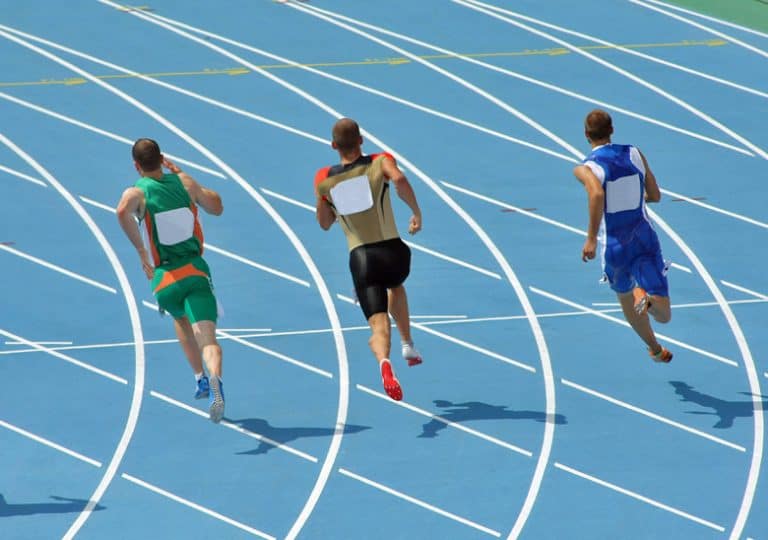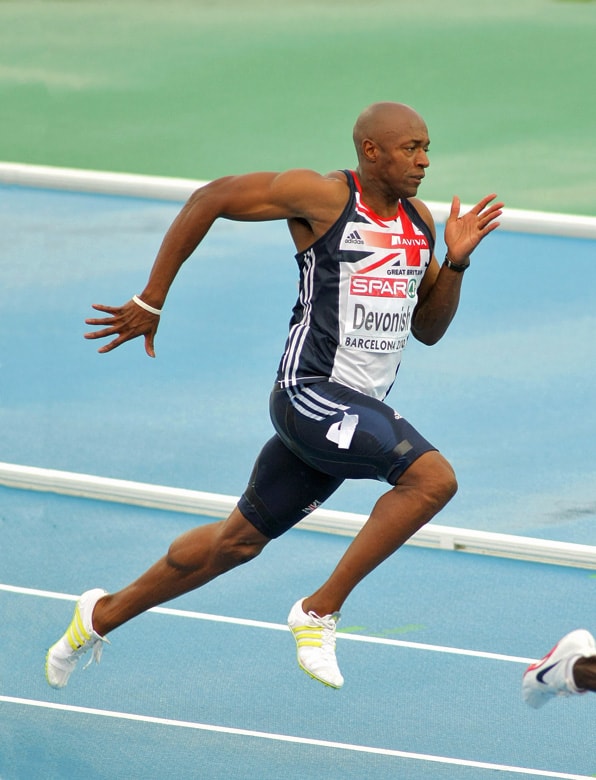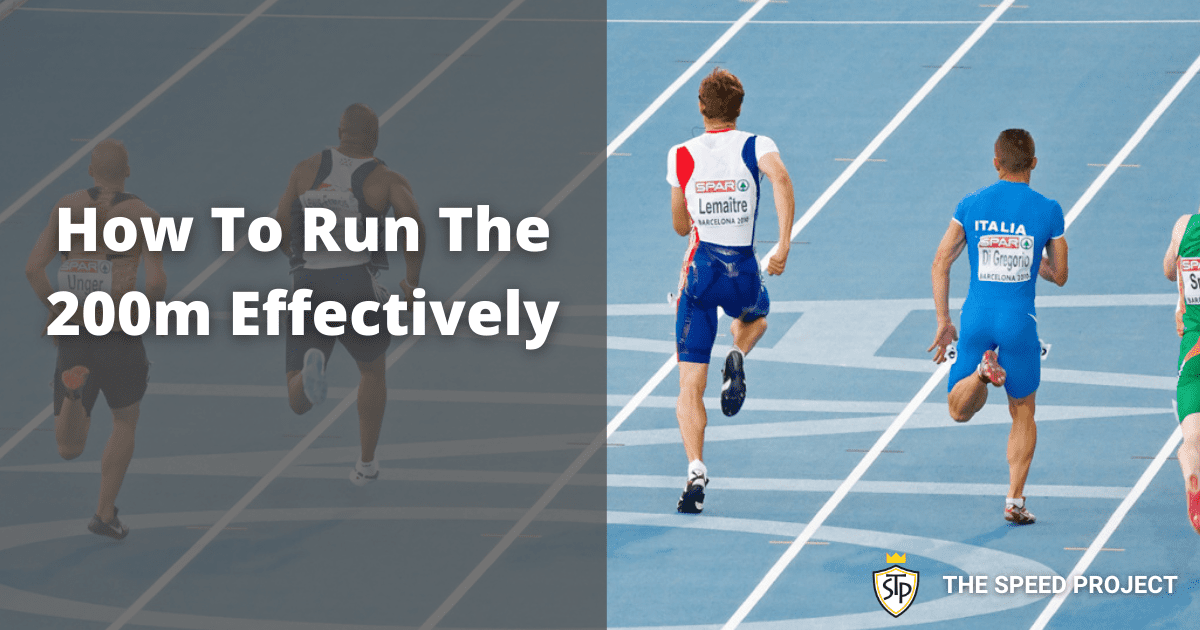The 200m is an event that combines the skills of power and speed endurance. The race requires the use of different energy systems from the 100m. It requires a lot more speed endurance work in your training to be successful.
It demands precision, development of neuromuscular patterns and strong sprinting form throughout. You also need a tactical plan which can differ from race to race depending on which lane you are in. It takes time and practice to be able to execute the 200m efficiently.
In this article, I will explain how to run 200m effectively.
Preparation For The 200m
Keeping more variables the same gives you the best opportunity to perform at your best each race. Here are some pre-race guidelines.
Blocks: Be sure to set up your starting blocks the same way in competition as you would during training. Don’t try implementing any changes during the competition as this could ruin your start. Anything new should be tried and tested during your training sessions.
Routine: You should have a routine that you go through before the start of every race. A lot of athletes take deep breaths in and out, do a few explosive jumps, slap their thighs to psyche themselves up etc.
Get in position: When the official tells you to take your marks, you should work yourself back into the blocks. I tell my athletes to imagine themselves as a coiled spring ready to pop.
Get into a position that is comfortable. Make sure your hands are behind the starting line and that the pressure remains on your feet and not on your hands.
Elements Of The 200m
I like to break the race down into phases so that my athletes can get a better understanding of how I want them to run each part.
Here I will explain the different phases of the race and how you should run them.
Phase 1: Attack The First 0-40m
Once you have taken your marks, listen out for the officials. During the set call, raise your hips and keep the pressure on your feet and not on your hands. This way, you’ll be able to explode from the starting blocks more forcefully.
Once the gun goes, push hard off of both feet, swing your arms to build momentum, and drive out of the blocks.
You want to attack the first 40m!
During this phase, your energy stores come from the ATP-PC energy system. This energy system is short-lived, so focus on being powerful to fire the muscle fibres into action during acceleration.
To do this successfully, explode from the blocks, driving your feet hard into the ground. This is not the same as the acceleration phase of the 100m. You’ll find that your drive is shorter as you come into your running stride as you take on the bend.
Phase 2: Glide Around The Bend For 40-110m
Running a successful bend can be the difference between winning and losing the race. After accelerating hard for the first 40m, you need to find your stride and ‘glide’ the bend.
This can be difficult for an athlete to understand let alone achieve. Gliding does not mean to slow down or exert less effort.
You want to take the momentum built up from your acceleration and use it to maintain your speed as you sprint the bend. This will allow you to run with a long and comfortable stride.
Running 150m from the 200m start line in training is a good way to practice this. Eventually, you will get a feel for it and know how much energy you have left in the tank once you come off the turn.

If you see athletes flying past you on the bend or way out in front, you don’t necessarily want to react. Remember that everyone is decelerating. If you are in a race where your times are competitive, chances are these athletes will run out of steam and you’ll catch them.
Note: Make sure you run your own race and stick with your plan! When you obsess over what others are doing then you have already lost. The race is short, you don’t have time to focus on anyone else.
To run a successful bend, you do not need to lean your body into the curve. Focus your sight on the point at which you want to run and your body will naturally follow around the bend.
Phase 3: Back On The Gas For The Next 110-140m
During this phase, you want to re-accelerate. Before you say this is impossible, I realise that this is not what is actually happening here. But it’s a good way to explain it for visual purposes.
As you come off the bend you want to kick start that rapid arm and leg movements that you produced during the first 40m.
You should feel a shift in your efforts (the re-acceleration) as you use that reserve that you saved from gliding the bend and continue for the next 30m.
It’s important from here on out that you focus on maintaining your speed and technique for as long as possible to avoid a breakdown in sprinting form.
Phase 4: Keep Your Technique For The Final 140m-200m
Once you hit the home straight with about 60m to go you will be able to feel your efforts diminishing.
At this point, it’s essential that you focus your efforts on a good sprinting form. Keep a tight core, and maintain a comfortable stride. This will help reduce any energy wastage from unnecessary movements.

Keep focused, maintain your technique and let this carry you across the finish line!
Note: Specific anaerobic training will help you improve in this phase of the race. Run sets focusing on maximising the potential of the glycolytic energy system.
Training For The 200m
Often, a good 200m runner can either drop down to 100m or even go up to 400m and still compete. Though it is rare for an athlete to compete seriously in all three sprint events (100m/200m/400m).
This is because 200m sprinters need to apply aspects from both the 100m and 400m training principles. Power is needed as well as speed endurance.
My 200m athletes will usually train with my 100m athletes. But it’s important that they also run longer distances at higher intensities. This will build up their speed endurance and strength.
This is easily achieved by implementing a longer running series, more sets, or less recovery time during training.
200m Warm-Up
A good warm-up will facilitate faster muscle contractions and prepare you for training. You need to make sure you get a lot of blood flowing so that oxygen is transported to the active muscles contracting.
200m warm up key points:
- 5 minutes of cardio
- Leg Swings
- Mobility drills
- Technique drills
- Accelerations x 2-3 x 30-50m
200m Sprint Training Program Examples
Sprint Training Session 1: 4 x 7 x 60m back-to-backs with 15 seconds/4 minutes recovery (acceleration).
Sprint Training Session 2: 120/100/80/60m x 2 with a walk back and 8 minutes of recovery (maximum velocity).
Sprint Training Session 3: 3 x 2 x 300m with a slow walk around and 8 minutes of recovery (speed endurance).

